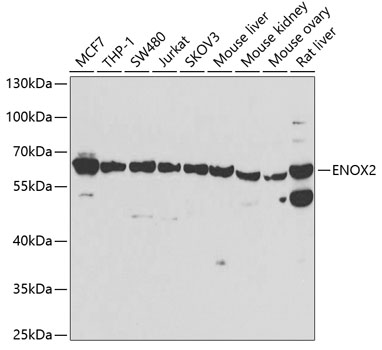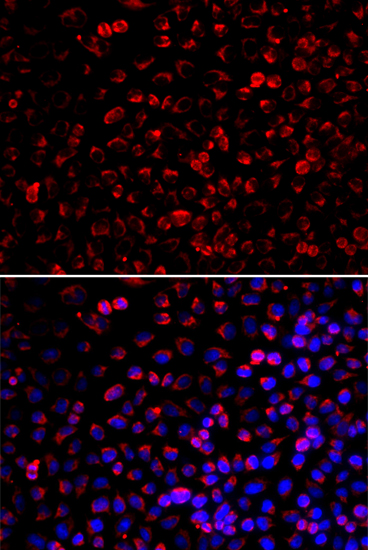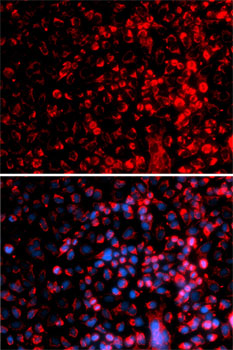-
Product Name
ENOX2 Polyclonal Antibody
- Documents
-
Description
Polyclonal antibody to ENOX2
-
Tested applications
WB, IF
-
Species reactivity
Human, Mouse, Rat
-
Alternative names
ENOX2 antibody; APK1 antibody; COVA1 antibody; tNOX antibody; ecto-NOX disulfide-thiol exchanger 2 antibody
-
Isotype
Rabbit IgG
-
Preparation
Antigen: Recombinant fusion protein containing a sequence corresponding to amino acids 411-610 of human ENOX2 (NP_872114.1).
-
Clonality
Polyclonal
-
Formulation
PBS with 0.02% sodium azide, 50% glycerol, pH7.3.
-
Storage instructions
Store at -20℃. Avoid freeze / thaw cycles.
-
Applications
WB 1:500 - 1:2000
IF 1:50 - 1:200 -
Validations

Western blot - ENOX2 Polyclonal Antibody
Western blot analysis of extracts of various cell lines, using ENOX2 antibody at 1:1000 dilution.Secondary antibody: HRP Goat Anti-Rabbit IgG (H+L) at 1:10000 dilution.Lysates/proteins: 25ug per lane.Blocking buffer: 3% nonfat dry milk in TBST.Detection: ECL Basic Kit .Exposure time: 15s.

Immunofluorescence - ENOX2 Polyclonal Antibody
Immunofluorescence analysis of U2OS cells using ENOX2 antibody . Blue: DAPI for nuclear staining.

Immunofluorescence - ENOX2 Polyclonal Antibody
Immunofluorescence analysis of MCF7 cells using ENOX2 antibody . Blue: DAPI for nuclear staining.
-
Background
May be involved in cell growth. Probably acts as a terminal oxidase of plasma electron transport from cytosolic NAD(P)H via hydroquinones to acceptors at the cell surface. Hydroquinone oxidase activity alternates with a protein disulfide-thiol interchange/oxidoreductase activity which may control physical membrane displacements associated with vesicle budding or cell enlargement. The activities oscillate with a period length of 22 minutes and play a role in control of the ultradian cellular biological clock.
Related Products / Services
Please note: All products are "FOR RESEARCH USE ONLY AND ARE NOT INTENDED FOR DIAGNOSTIC OR THERAPEUTIC USE"
